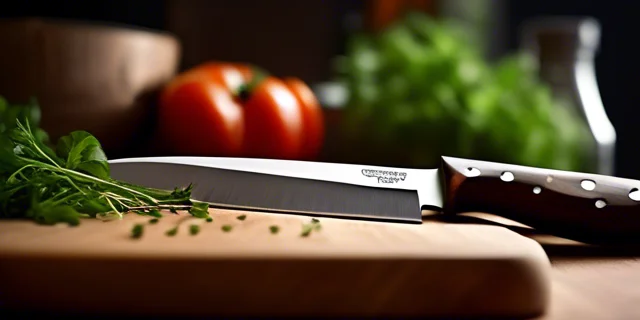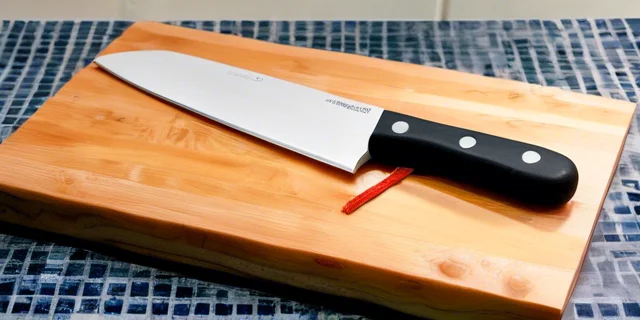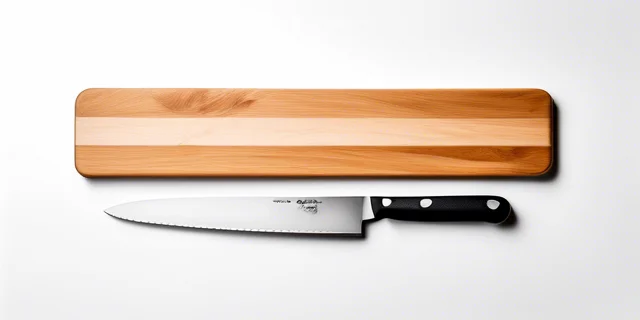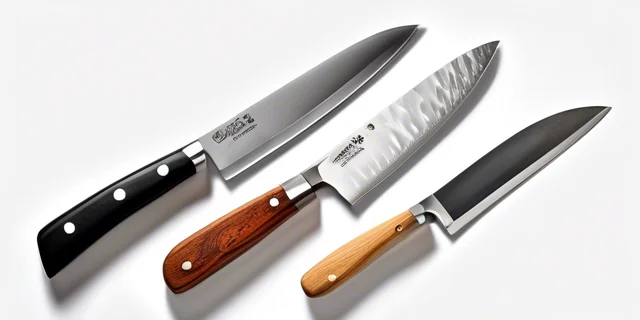As an Amazon Associate I earn from qualifying purchases.
Introduction
The chef’s knife, also known as a cook’s knife, is an indispensable multi-purpose kitchen tool used by both professional chefs and home cooks. This versatile knife is designed to handle a wide variety of cutting, chopping, slicing, and dicing tasks with ease and precision.
Often considered the most essential knife in any cook’s arsenal, a quality chef’s knife can significantly improve efficiency and skill in the kitchen. Like an extension of the hand, it enables the cook to swiftly and safely tackle meal prep ingredients including meat, fish, vegetables, herbs, and more.
This comprehensive guide covers everything you need to know about what are chef knives used for. We’ll explore the key features, anatomy, materials, techniques, care, and maintenance required to use a chef’s knife effectively. Whether you’re outfitting your first kitchen, upgrading your knives, or looking to improve your chopping skills, understanding the chef’s knife is a crucial step on the culinary journey.
Anatomy of a Chef’s Knife
The chef’s knife is characterized by its signature broad, triangular-shaped blade which curves to a sharp, fine point at the tip. While shapes and sizes vary, several standard components make up the anatomy of a chef’s knife.

The Blade
The blade of a chef’s knife typically ranges from 6 to 14 inches long, with the most common sizes falling between 8 and 10 inches. Shorter blades provide ultimate control and are ideal for tasks like mincing herbs or ginger. Longer blades offer greater slicing power needed for chopping through dense vegetables or cutting meat.
In terms of width, Japanese-style blades tend to be thinner and lighter, while German and Western-style knives feature thicker, heavier blades. The width impacts the knifes’s ability to chop through thicker or harder ingredients.
An optimal chef’s knife will feel like an extension of your hand, allowing you to wield it with comfort and control. Consider your own size, cutting style, and usage when choosing the length and width that feels balanced.
The Edge
The edge refers to the sharpened cutting side that slices through ingredients. High-quality knives are sharpened to 15-20 degrees per side for a razor-sharp 30-40 degree total edge. Maintaining this delicate edge is key to knife performance.
The edge starts at the tip and extends towards the heel in a gentle curved slope. This rocking profile facilitates fast chopping with a rocking motion. Some Japanese blades feature a straight edge for precise cuts vs rocking.
The Spine
The spine is the thick, unsharpened top side opposite the cutting edge. This spine continues through the handle providing strength and balance. The upper area near the tip is useful for tasks like cracking peppercorns or crushing garlic cloves.
The Tip
The tapered tip is shaped to a sharp point, which aids in tasks like mincing, slicing, or cutting out imperfections. A rounded tip has less piercing power but is more durable. The sharpness of the tip must be maintained through careful honing and sharpening.
The Heel
Located where the handle meets the blade, the heel is the widest part often used for chopping. The forefinger grips here in the pinch hold. The weight of the heel facilitates heavy chopping, rocking, and leverage.
The Bolster
The bolster provides balance by adding weight at the end of the blade near the handle. This thick metal band strengthens the junction between handle and blade. A full bolster extends to the knife’s spine, while a half bolster ends below.
The Handle
The handle provides grip, with the best chef knives having contoured, ergonomic handles that feel comfortable. Full tang models extend the metal from tip through the handle for durability. Scales or coverings on both sides of the handle protect from temperature and improve grip.
Chef Knife Blade Materials
The material used for the blade is one of the most important factors in determining the performance and longevity of a chef’s knife. Here are some of the common types of steel and other metals used in knife construction:
Carbon Steel
Carbon steel blades are known for their strength and ability to hold an extremely sharp edge. They are harder than stainless steel and maintain their sharpness longer. However, carbon steel is more prone to rusting and needs extra care to prevent discoloration.
Stainless Steel
The addition of chromium creates stainless steel, which resists corrosion and doesn’t rust or stain easily. It still requires some maintenance though and doesn’t hold as fine an edge as carbon steel. Different grades exist, with higher-end stainless steels like VG-10 providing better edge retention.
High-Carbon Stainless Steel
This blend combines the benefits of carbon steel and stainless steel. Knives made from high-carbon stainless have impressive hardness, edge retention, and resistance to corrosion. However, they are trickier to sharpen than pure carbon steel.
Damascus Steel
Damascus steel is primarily aesthetic, with intricate wavy or ladder patterns formed by layering stainless steel alloys. The layers are forged and welded together, then acid etched to bring out the dramatic patterns. Damascus is tough and flexible but requires extra sharpening effort.
Ceramic
Ceramic knife blades are made from zirconium oxide and hold their edge up to 10 times longer than steel. However, they chip easily if dropped and are not as versatile as steel for heavy duty chopping tasks.
Chef’s Knife Handle Materials
While the blade is the star of the show, the handle shouldn’t be overlooked. A comfortable, durable, and hygienic handle is essential for providing grip and control. Modern chef’s knife handles are constructed from:
Stabilized Wood
Stabilized wood has been processed to reduce shrinking, cracking, and expansion from water and heat. Dense woods like pakkawood or ironwood are common. Stabilized wood provides a traditional look with natural grain patterns. However, they can deteriorate over time.
Plastics
Durable plastics like polyoxymethylene (POM), Santoprene, or polypropylene are molded into ergonomic handles. They offer textured grips, vibrant colors, and moisture resistance. However plastics can become brittle over time.
Composite Materials
Handle scales made from fiberglass-resin composites like G10 (fiberglass reinforced epoxy) or Micarta (linen or paper reinforced phenolic resin) are highly popular. These materials excel in toughness, grip, and stability over prolonged use.
Micarta offers a more natural, subdued appearance compared to the layered, colorful look of G10. For superior durability and moisture resistance, G10 is the winner between the two.
Metals
Some handles are constructed entirely of metal alloys. Stainless steel and aluminum provide hygienic, durable handles but can be slippery. Dimpled indentations help improve grip. Metal conducts heat easily, making extended use uncomfortable.
What Are Chef Knives Used For ? Cutting Techniques
One reason the chef’s knife is so indispensable is its versatility in enabling various cutting techniques. Here are some of the main techniques used for preparing fruits, vegetables, herbs, and proteins:

Chopping
In chopping, the chef’s knife is used to cut ingredients into rough or coarse irregular pieces. Using the front half of the blade, a rocking motion is used with the tip anchored to the cutting board. Chopping is great for breaking down vegetables for soups or sautés.
Dicing
Dicing produces perfectly cubed pieces sized small, medium or large. Make perpendicular cuts to precisely cube the ingredient. When dicing onions, it helps to cut root to stem first to stabilize, then make horizontal cuts. Sharpening between cuts helps maintain clean edges.
Mincing
Mincing involves making very fine cuts to break food down into tiny uniform pieces. The heel is rocked across the ingredient using the tip as a pivot point against the board. Mincing is ideal for foods like garlic, ginger, herbs, and shallots.
Slicing
Slicing is cutting ingredients into thin, even pieces. Ensure your slices are consistent in size and thickness. Let the knife’s sharpness do the work rather than sawing. Slicing is used for meats, breads, delicate fruits, and vegetables like tomatoes.
Julienne
To julienne means cutting into thin matchstick strips. Stack ingredients and make even slices before cutting lengthwise into batons then julienne. Carrots, zucchini, potatoes, and cabbage are often julienned to uniform size for even cooking.
Chiffonade
Chiffonade refers to thinly slicing leafy greens into ribbons by stacking leaves, tightly rolling, then thinly slicing. Basil, mint, and spinach are commonly chiffonade’d for salads, garnish, or sauces. Keep your fingers tucked in to avoid nicks.
Batonnet
Batonnet produces square shaped sticks that are larger and thicker than julienne cuts.Trim ingredients into a rectangular shape before slicing into batons. Potatoes are often cut into batonnets for dishes like homemade fries.
Rondelle
Rondelle refers to rounding vegetables or fruits into disc shaped slices.Slice across thin pieces to make circular rondelle cuts. Onions, shallots, lemons and potatoes are often cut into rondelles for an attractive presentation.
Proper Knife Grips
Using the proper grip keeps your fingers safe and provides control. The two most common grips are:
Pinch Grip
The pinch grip, also called the blade grip, involves grasping the sides of the blade near the heel with your thumb and forefinger. The remaining fingers curl around the handle for support.
This grip gives you finger control over the tip for detailed work like mincing. It also provides stability in guiding the rocking motion used for chopping and slicing.
Handle Grip
In the handle grip, your entire hand firmly holds the handle while your thumb presses on the neck of the handle. This provides a very secure grip ideal for applying pressure and power in tasks like cutting through dense vegetables or raw meat.
Try both grips to see which feels most comfortable based on the ingredient, task, and size of your hands. The most important thing is keeping your fingers safely tucked in a claw hold position.
Master Proper Cutting Techniques
With a quality chef’s knife and proper grip, focus on using good form and techniques for optimal results:
Slicing
When slicing fruits, vegetables, meat, and other ingredients, use fluid, even strokes without sawing back and forth. Let the sharp edge of the knife do the work for you. Make sure your cuts are uniform in size and thickness.
Dicing
For clean, precise dices, start by cutting sticks of even thickness and length. Stack them and make perpendicular cuts across the batons. Aim for consistency in the size of the dice pieces. Sharpen as needed between cuts for best results.
Mincing
Mince garlic, ginger, herbs, or other foods by anchoring the tip to the board while rocking the heel in a steady, downward motion across the ingredient. Use the force from the heel to make fine, concentrated cuts all the way through for uniform mincing.
Chopping
When chopping, use the front half of the blade to make swift rocking cuts, keeping the tip anchored to the board. Let the knife do the work rather than forcing with the shoulders. Use smooth motions rather than hacking chops for clean cuts.
Caring for Your Chef’s Knife

A chef’s knife represents a significant investment for serious cooks. Follow these care tips to maintain knife performance and longevity:
- Hand wash knives immediately after use and dry thoroughly with a soft towel. Don’t let moisture linger on the blade which can breed bacteria.
- Never put knives in the dishwasher which can damage the edge and handle over time due to the harsh detergent.
- Store chef’s knives safely in a wooden knife block, sheath cover, or specially designed drawer insert to protect the delicate edge. Avoid loose drawers where blades collide and chip.
- Invest in a honing steel rod. Use it regularly before and during cooking sessions for straightening and realigning the knife’s edge between sharpenings.
- Sharpen with a quality whetstone or paid professional service several times per year to restore the V-shape edge. Don’t let knives become dangerously dull.
- Avoid glass, marble, or granite cutting boards which quickly dull knife edges. Use end-grain wood or soft poly boards instead.
- Never use a chef’s knife on frozen foods, bones, or other hard objects which can chip the blade.
- Consider having knives professionally sharpened if uncertain about whetstone sharpening. It takes training to sharpen at the ideal 15-20 degree bevel angle.
The bottom line is keeping your chef’s knife properly maintained through honing, sharpening, and general care pays dividends in performance, safety, and longevity. Respect this essential culinary investment by mastering knife skills and care.
Building Knife Skills Through Recipe Practice
Once you’ve covered the basics of your chef’s knife, one of the best ways to elevate your skills is practice! Work on key techniques by preparing recipes focused on produce prep, herb prep, and meat/fish prep. Here are some suggestions:
Vegetable and Fruit Preparation
Refine chopping, slicing, and dicing by making:
- Salads – Caesar, wedge, cucumber, chickpea
- Crudités platters
- Soups and chilis
- Stir fries
- Roasted veggies
- Sauces like marinara or ratatouille
Herb Preparation
Hone mincing and chiffonade skills with recipes involving:
- Compound butters
- Pesto
- Chimichurri
- Salad dressings
- Infused oils
- Fresh salsas and sauces
Meat and Fish Preparation
Build proficiency in portioning, trimming, and slicing meats by preparing:
- Fillets of salmon, tilapia, trout
- Chicken or turkey cutlets and breast
- Pork chops and tenderloin medallions
- Steak, beef, or lamb for carving
- Kebabs or skewers
These recipes help engrain proper knife techniques as you build confidence and speed with your chef’s knife. Soon you’ll be able to tackle any meal prep scenario thrown your way.
Key Takeaways on the Essential Chef’s Knife
The indispensable chef’s knife belongs in every cook’s arsenal of essential kitchen tools. Key benefits include:
- Multipurpose functionality – Tackle diverse cutting, chopping, and slicing tasks from proteins to produce with ease.
- Efficiency – Save time and energy compared to struggling with inadequate knives.
- Control and precision – Grip, leverage, and sharp edge allows accurate cuts.
- Confidence – Conquer recipes and techniques with this kitchen workhorse at your side.
- Safety – Properly wielding a sharp chef’s knife is safer than a dull knife requiring excessive force.
While this guide provides a comprehensive overview, don’t overthink things. Pick up a quality chef’s knife, practice good technique, and let experience be your guide. The chef’s knife will quickly become an extension of your hand, facilitating the joy of cooking for years to come.
As an Amazon Associate I earn from qualifying purchases.

